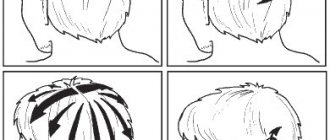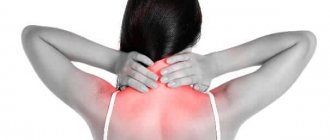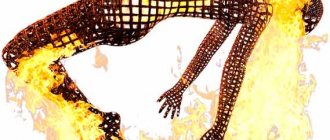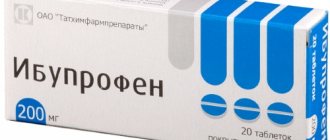When your back feels hotter than the rest of your body, it can be a serious cause for concern, especially if the symptom occurs suddenly and is not accompanied by other problems.
Isolated cases of elevated temperature in the back usually do not indicate serious disorders. Some people are simply more sensitive to heat than others. However, concern should be shown if such a problem bothers a person frequently or occurs along with other symptoms.
In many cases, the feeling of heat occurs when skin or nerve problems develop in the back or spine. Such problems are usually treatable.
In this article, we'll explain why your back may feel warm or hot, as well as look at the associated symptoms of related medical conditions and how to treat them.
The main causes of burning in the temples
What are the reasons for a burning pain in the head? There are many of them. More often, the feeling that the brain is on fire occurs in older people, but young people are also not immune to it.
Overwork, stress
Constant overwork and stress, caused by the depletion of the body's internal reserves, leads to negative consequences and diseases that can become chronic.
The tone of the blood vessels in the brain is disrupted, and difficulty in blood flow occurs, which is often manifested by burning skin in the back of the head and dizziness. Lack of oxygen leads to numbness in the limbs, sudden clouding of consciousness, darkening or fog in the eyes.
Causes
Listed below are the most common causes of a hot back.
Nerve related pain
Nerve-related pain is the most common cause of a burning, tingling, or warming sensation in the back.
While muscle pain is tense, tender, and often achy, nerve pain can cause unusual sensations, such as:
- feeling of heat;
- tingling;
- numbness;
- shooting pain;
- sudden shocks, which in their nature resemble the feelings that arise from electric shock.
An increasing feeling of warmth is a type of neurological pain. Damaged or pinched nerves cannot transmit normal signals, so the body may interpret the sensation as fever.
People with diabetes may develop a type of nerve pain called diabetic neuropathy. High levels of glucose and triglycerides in the blood can damage nerves over time and cause unusual or painful sensations, including numbness, tingling, or burning.
The most common type of neuropathy is peripheral neuropathy, which affects the feet and hands. However, some people experience focal neuropathy, which affects or pinches single nerves, most commonly in the torso, arms, legs and head.
Radiculopathy is pain that results from compression, inflammation, or damage to the spinal cord nerves. Radiculopathy can cause pain in any part of the back. This pain is usually specific and stable, although it may worsen over time.
Sciatica is a common type of radiculopathy that compresses the sciatic nerve that runs from the back of the thighs into the legs.
Sciatica can cause pain in the lower back, as well as an electric sensation or burning sensation that radiates to the buttocks and legs.
Sunburn
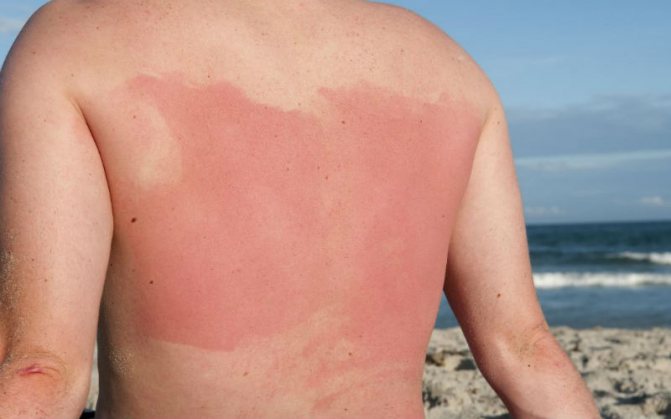
Sunburn can cause burning and stabbing pain
When the weather is hot and sunny outside, ultraviolet rays can burn your skin. Backs and shoulders get sunburned easily when people spend a long time in the sun in swimsuits or tank tops.
Sunburn usually causes an intense feeling of heat when people touch the affected area. The skin in such situations usually becomes red, and over time it begins to peel off.
Some medications may increase the risk of sunburn. These include retinoids, salicylic acid, sulfonamides, nonsteroidal anti-inflammatory drugs (NSAIDs) and certain diuretics. In most cases, sunburns heal without any treatment, but they can cause severe pain and increase the risk of developing skin cancer.
Severe burns cause blistering, as well as dehydration, fever, chills and other serious symptoms. People with such problems may need medical help.
Skin infections
Skin infections can cause a hot sensation when you touch certain areas of the body. This symptom develops due to inflammation as the body tries to fight infection.
What tests should I take?
To determine the reason why the head is warm, you need to conduct a series of diagnostic studies. The examination is carried out by a neurologist. During the diagnostic process, consultations with an ENT specialist, psychotherapist, therapist, ophthalmologist, neurosurgeon, etc. may be required.
The table presents the main methods that help to establish the cause and relieve the feeling that the forehead is burning:
| Analysis/research | Description |
| General and biochemical blood tests | They help assess the patient’s general condition and detect chronic diseases. |
| Electroencephalography (EEG) | Registers natural electrical discharges of the brain and displays them in the form of a graph. Allows you to exclude epilepsy and evaluate brain function. |
| Echoencephalopathy (EchoES) | The method is based on the Doppler effect (ultrasound). Allows you to identify large formations. |
| 24-hour blood pressure monitoring (ABPM). | Detects arterial hypertension. Involves measuring blood pressure over 24 hours and calculating average values. |
| Magnetic resonance imaging (MRI) | Detects vascular diseases and small tumors. |
Cervical osteochondrosis
Osteochondrosis is a disease associated with deformation of the vertebrae and degenerative changes in nearby tissues. There is a disruption in the blood supply to the brain, which leads to cephalgia, tinnitus, loss of vision, and sometimes disability. In recent years, this disease has been spreading at epidemic speed and affects young able-bodied men and women aged 25 to 40 years.
This kind of pain needs to be diagnosed.
Unfavorable factors include:
- prolonged sitting at the computer;
- talking on the phone with the receiver clamped between the ear and shoulder;
- sitting in a car for a long time;
- sedentary lifestyle.
A burning sensation in the occipital region of the head is the main symptom. Joining him:
- aching pain in the back of the head, neck;
- the shoulder burns, the hands may become numb;
- heat in the face;
- burning at the level of the shoulder blades.
The pain is quite strong and begins to intensify with movements of the head, eyeballs and spreads to the neck, shoulders, and back of the head.
With osteochondrosis, headaches often occur spontaneously. It is paroxysmal and the painful sensations do not gradually increase, but instantly reach their highest peaks. The attacks last about 10 minutes, mainly in the morning and reduce the ability to work, cause neuroses and changes in blood pressure.
Osteochondrosis is a degenerative and irreversible process, and in order to stop it, immediate examination and treatment is required. In addition to analgesics and antispasmodics, the patient is prescribed drugs that improve cerebral circulation and relieve muscle tension. Treatment is supplemented with vitamin B and nicotinic acid.
How to treat a feeling of heat in the head?
There is no standard treatment for diseases that give rise to the feeling that the back of the head is burning. If a burning sensation on the face occurs due to cervical osteochondrosis, treatment is aimed primarily at neutralizing the pathology. If the cause is frequent stress and overwork, treatment with antidepressants and sedatives is prescribed. For muscle spasms, massage and antispasmodics (for example, Spazmalgon) are indicated.
Several methods are used to get rid of burning sensation in the head area:
- manual therapy (special massage procedures);
- acupuncture;
- therapeutic exercises and a set of special exercises.
The main goal of therapy is to relieve tension from the muscles of the neck and shoulders. Doctors also prescribe courses of medications several times a year. The duration of one course is at least a month.

Treatment with tablets
If the top of your head burns afterwards, your forehead burns, or your skin tingles, you can take some painkillers as an emergency measure. After relief, it is recommended to consult a doctor. The following medications are usually taken:
| Name of tablets | How to use |
| Tampalgin | Contains analgin and tempidone. Effective for headaches and toothaches. Take 1 tablet up to three times a day. |
| Citramon | A product based on caffeine, citric acid, cocoa powder. The combined composition allows you to achieve maximum effect. Take 2 tablets three times a day. |
| Pentalgin | It contains a lot of components (analgin, caffeine, amidopyrine, etc.) In addition to the analgesic effect, it calms and normalizes sleep. |
Traditional methods
Traditional medicine suggests treating a symptom such as a burning headache with warming. This is justified only if the head is hot due to cervical osteochondrosis.
- Wrap yourself in a woolen scarf or make a hot compress with horseradish leaves and boiled potatoes. Remember that it is not the head that needs to be warmed up, but the cervical spine.
- Burning skin can be easily cured with pepper plaster or mustard plaster. As they say, we knock out wedges with wedges.
- For brave patients, there are recipes for rubbing radish tincture or honey in alcohol to help relieve the burning sensation.
- Fresh juices of celery, carrots, and pomegranate will help strengthen the walls of blood vessels and improve blood supply.
- A good recipe is to consume garlic and lemon in a blender on an empty stomach.

Exercises to relieve pain and burning in the back of the head
Causes and symptoms of neck pain It is impossible to name one reason that causes neck pain in people.
However, there is evidence that people with long necks experience them more often than those with short necks; Men suffer from cervical spondylosis more often than women. Pain in the cervical spine most often affects those whose profession involves driving on bad roads: journalists, medical workers, representatives of executive bodies, etc. The most common causes of pain in the neck are: degenerative changes in the vertebrae of the cervical spine; immobility of the head for a long period of time, for example, when watching TV; injuries; poor posture when writing, reading or working at the computer; anxiety and stress;
Cervical spondylosis is dangerous because it begins suddenly and quickly. At first, the person may experience mild pain and anxiety. Before an attack of cervical spondylitis begins, there are sometimes periods of short-term loss of neck mobility. During an attack of the disease, the neck becomes rigid, and even a slight pressure on it with the fingers immediately causes pain to the person, which can radiate into the hand all the way to the fingers.
Untreated cervical spondylosis can become chronic over time. At the same time, with age, neck pain becomes less and easier to bear.
Stress can also be a cause of neck pain, as staying in such a state for a long time takes its toll on the entire body.
General treatment At the very beginning of the disease, when pain suddenly occurs in the cervical spine, you should rest a little and wait until the pain subsides a little. If it does not decrease even after rest, it is recommended to wear an orthopedic collar. It allows injured or strained muscles to rest, causing the pain to gradually subside.
Regularly performing special exercises for the neck helps. More details about them will be said later. It is very important to know that if you have pain in the cervical spine, it is not recommended to stretch it.
In cases where neck pain suddenly arises as a result of overexertion, the best medicine is rest. Everyone has seen how runners at sports competitions, crossing the finish line, bend over from fatigue in order to restore their breathing. The same is true for a tired neck. After incorrect body position during sleep and sitting or prolonged work at the computer, the neck also needs rest.
Often, when a doctor recommends a patient to rest first, many patients are very willing to follow his advice and rest for too long, which is no longer beneficial. Therefore, it is necessary to check with the doctor the duration of this period and not take into account that the neck should rest only until the attack of pain subsides.
In addition, heat treatment can be used to treat neck pain. If the mobility of the cervical spine deteriorates, heat brings some relief, as it relieves aching pain. The process will be more effective if you apply a hot compress before doing neck exercises. The most commonly used solutions are hot water bottles and electric pads. If the pain is severe, you can apply hot water bottles to your neck, however, for no longer than 15 minutes.
Hot pillows are easy to make at home by folding a piece of cotton or wool fabric 6-8 times, then placing it on a hot stove to heat. You can then press the fabric towards your neck. After several applications, the compress needs to be heated again. It should be remembered that after such warming up, you should not expose your neck to cold air; it is best to immediately wrap it up.
If the neck is not inflamed or red, you can apply hot compresses. To do this, you need to take a woolen cloth, fold it and immerse it in very hot water, wring it thoroughly and wrap it around your neck. As in the previous case, it is unacceptable to go out into the cold after this compress; it is best to immediately wrap your neck. This compress is applied daily for 15-20 minutes 2-3 times a day, depending on the intensity of the neck pain.
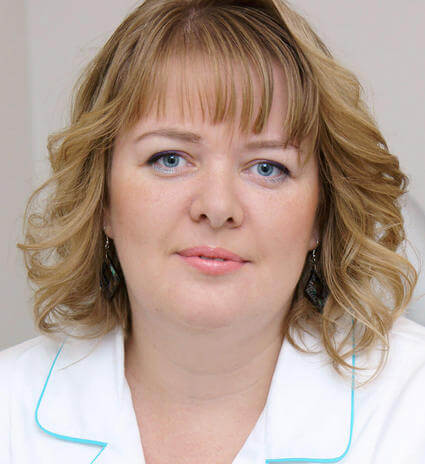
An infrared lamp has a very good effect for warming up the neck. It must be remembered that the lamp should be kept at a distance of at least 45 cm from the skin, the duration of one session should not be more than 20 minutes. It should be remembered that after such warming up, you should also not expose your neck to cold air; it is best to immediately wrap it up.
Neck exercises These exercises are aimed at strengthening neck muscles weakened by disease. It’s even worth making it a rule to do special exercises for the neck, but the daily dose of exercise should be carefully selected with the help of a therapist, so that the movements performed in no way lead to neck deformation, aggravating the situation. Properly selected neck exercises help prevent pinching.
Neck bends to the side Tilt your head to the side as low as possible to your right shoulder, then to your left. This should be repeated no more than 10 times, but gradually the number can be increased to 30.
Tilts of the head forward and backward It is very important to make the neck more flexible for the prevention and treatment of neck diseases. For this purpose, you can use this exercise - tilting your head forward and backward. This exercise is very simple, so you can do it even while lying on the bed. It is better to place a flat pillow under your neck (not under your head, but under your neck).
Now you need to alternately tilt your head forward and tilt it back. If you do this exercise while standing, your neck will become more tired. You need to start bending slowly; in the first stages of training, it is recommended to tilt your head forward and back no more than 10 times. Then, the number of repetitions can be gradually increased to 30. It is important that all movements, both in this and other exercises, be performed very slowly, without jerking.
Neck rotation Neck rotations are performed while sitting. Rotate your head in a circle, first from left to right, then from right to left. This exercise must be done very slowly. This should be repeated no more than 10 times, but gradually the number can be increased to 30.

Nodding your head forward and shaking your head in denial This exercise is especially useful for those people who work a lot at the computer. The exercise can be performed even while working. It is very easy to do. When a person agrees with the opinions of others, he nods his head as a sign of confirmation. Nod the same way, lowering your head halfway, and then shake your head as if you object.
Neck stretch Before performing the exercise, moisten your right palm with water or mustard oil and press it against the neck muscles on the left side, then move them to the left as far as possible. After this, wet your left palm and do the same only now on the right side. This exercise must be performed at least 10 times a day.
Neck massage Wet your palms with mustard oil and slowly massage your neck. It is better to start by massaging the muscles under the chin, then turn your palms up and move them forward and upward 10-15 times. After this, massage the neck from front from left to right, then vice versa from right to left. Lastly, the back of the neck muscles are massaged, first from left to right, then from right to left.
Holding the neck on weightIn another way, this exercise is also called raising the neck. Before performing, lie on your stomach with a small pillow under it, stretch your arms along your hips, and turn your palms up. After this, exhale and slightly lift your upper body. Now you need to hold your breath for about 4-5 seconds. Repeat this exercise 5 times. After 2-3 days, increase the number of exercises to 10 times a day.
Exercise for brachial pain This exercise will be especially useful for those people who have pain in the neck that is reflected in the arms and hands. You should take a chair with a back and armrests, sit on it so that your elbows rest on the armrests, but your back should not touch the back of the chair. You need to sit upright, transferring the weight of your entire body to your forearms and elbows, while clasping your fingers on your stomach.
How to prevent the disease?
To ensure that such a symptom as a burning neck, pain in the top of the head never occurs, you should undergo medication treatment prescribed by a doctor, and also reconsider your lifestyle:
- walk outdoors more often;
- walk more;
- do not slouch, try to keep your back straight;
- eat healthy, vitamin-rich foods. Food should be fresh and homemade;
- discuss taking hormonal medications and contraceptives with your doctor;
- get a good night's sleep;
- engage in a strengthening and at the same time relaxing sport: Pilates, yoga, qigong gymnastics, calanetics, wushu;
- stop smoking and drinking alcohol or minimize the amount of harmful substances entering the body;
- undergo treatment with a psychotherapist;
- properly treat all diseases of the ear, nose and throat (sinusitis, sinusitis, frontal sinusitis, otitis);
- Master techniques for quickly calming down in stressful situations (proper breathing, meditation, etc.).
Treatment

You should consult a doctor if back pain and other symptoms become difficult to bear.
The choice of treatment for a feeling of heat in the back depends on the cause of the problem. It is mandatory to go to the hospital when the pain is intense and insurmountable. In addition, medical support should be sought if pain occurs along with other problematic symptoms, such as fever or general malaise.
It is recommended to call emergency medical care if symptoms of the following conditions develop:
- kidney stones;
- cellulite or infected wounds;
- severe sunburn.
Doctors usually prescribe antibiotics to treat the infection. With severe sunburn, people sometimes need IVs. Your doctor may also prescribe medications to help relieve pain.
Heartburn usually responds well to over-the-counter medications. Some people find that they can reduce the incidence of heartburn by eating smaller portions of food or avoiding foods that are too acidic.
However, if heartburn is severe or occurs regularly, people should consult a doctor because the problem may indicate a more serious condition, such as GERD. Prescription medications for GERD are usually helpful in managing chronic symptoms.
Kidney stones often do not require treatment, but when they pass from the body, your doctor may prescribe medications to relieve the pain. If the stones do not pass or the pain is uncontrollable, your doctor may recommend surgery to remove the stones.
Approximately 80 to 90% of patients with sciatica are treated without surgery. Cold and heat treatment, as well as physical activity, allow the body to recover faster. Stretching and physical therapy may also help. If a person finds it difficult to bear the pain, the doctor may suggest spinal injections.
Unfortunately, sciatica is difficult to treat for some people. If symptoms last longer than three months or get worse, your doctor may recommend surgery to relieve pressure on the pinched nerve.
Treatment of diabetic neuropathy begins with attempts to control the patient's blood glucose levels. Some medications can help relieve pain and numbness. In addition, people may find that physical therapy provides relief from symptoms.
Why does my neck sweat exclusively at night?
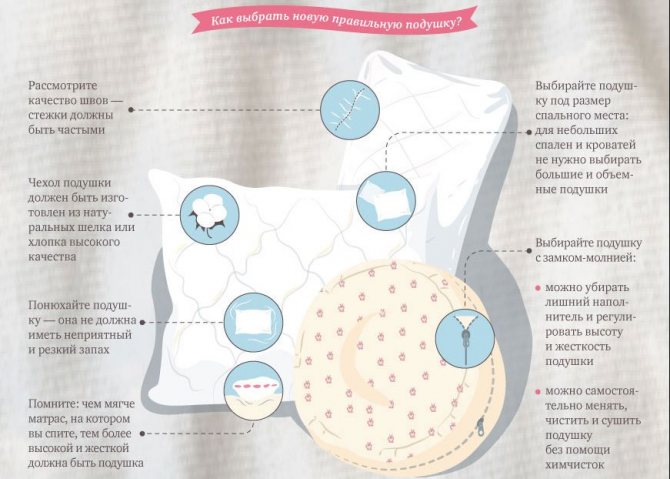
To prevent neck and neck sweating during sleep, you need to choose a quality pillow.
This symptom most often indicates an illness, although there may also be causes that are typical for daytime hyperhidrosis, especially heat and high humidity. This in itself can be dangerous, as the person risks catching a cold. So, night sweats in the back of the head or the entire neck are associated with:
- infectious diseases;
- disruption of the endocrine system (diabetes mellitus, hypothyroidism);
- disruption of the cardiovascular system;
- oncology;
- autoimmune diseases.
Doctors often focus on this symptom when trying to diagnose tuberculosis at an early stage.
Please note that about a third of all cases of sleep hyperhidrosis are idiopathic. This means that doctors cannot establish the true causes of the phenomenon. If the patient has never had chronic diseases, then experts recommend that he adjust his lifestyle. Otherwise, you should undergo periodic examinations and tests for infectious and oncological diseases.
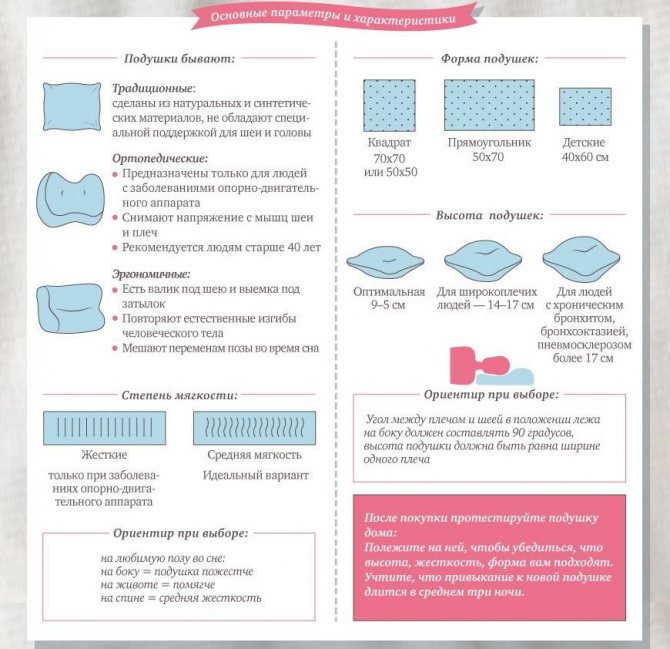
To avoid overheating and sweating your neck, you need to choose the right pillow for you.
